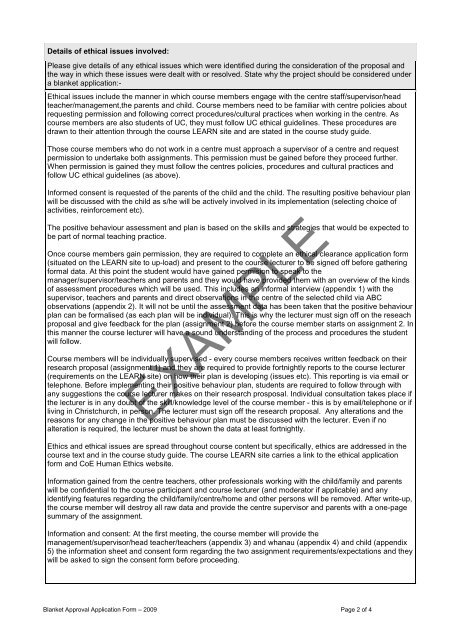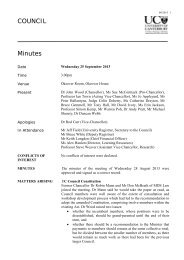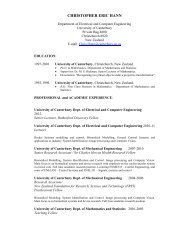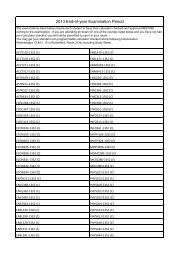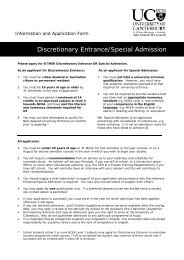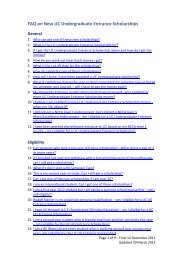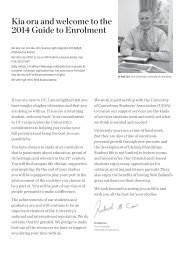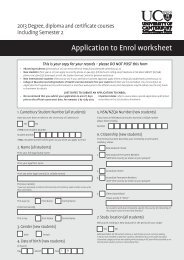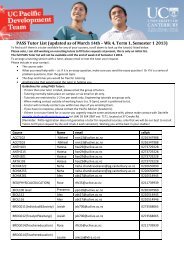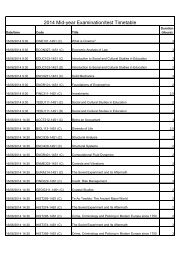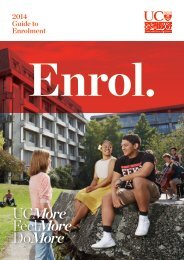Example Blanket Application Form - University of Canterbury
Example Blanket Application Form - University of Canterbury
Example Blanket Application Form - University of Canterbury
- No tags were found...
You also want an ePaper? Increase the reach of your titles
YUMPU automatically turns print PDFs into web optimized ePapers that Google loves.
Details <strong>of</strong> ethical issues involved:Please give details <strong>of</strong> any ethical issues which were identified during the consideration <strong>of</strong> the proposal andthe way in which these issues were dealt with or resolved. State why the project should be considered undera blanket application:-Ethical issues include the manner in which course members engage with the centre staff/supervisor/headteacher/management,the parents and child. Course members need to be familiar with centre policies aboutrequesting permission and following correct procedures/cultural practices when working in the centre. Ascourse members are also students <strong>of</strong> UC, they must follow UC ethical guidelines. These procedures aredrawn to their attention through the course LEARN site and are stated in the course study guide.Those course members who do not work in a centre must approach a supervisor <strong>of</strong> a centre and requestpermission to undertake both assignments. This permission must be gained before they proceed further.When permission is gained they must follow the centres policies, procedures and cultural practices andfollow UC ethical guidelines (as above).Informed consent is requested <strong>of</strong> the parents <strong>of</strong> the child and the child. The resulting positive behaviour planwill be discussed with the child as s/he will be actively involved in its implementation (selecting choice <strong>of</strong>activities, reinforcement etc).The positive behaviour assessment and plan is based on the skills and strategies that would be expected tobe part <strong>of</strong> normal teaching practice.Once course members gain permission, they are required to complete an ethical clearance application form(situated on the LEARN site to up-load) and present to the course lecturer to be signed <strong>of</strong>f before gatheringformal data. At this point the student would have gained permision to speak to themanager/supervisor/teachers and parents and they would have provided them with an overview <strong>of</strong> the kinds<strong>of</strong> assessment procedures which will be used. This includes an informal interview (appendix 1) with thesupervisor, teachers and parents and direct observations in the centre <strong>of</strong> the selected child via ABCobservations (appendix 2). It will not be until the assessment data has been taken that the positive behaviourplan can be formalised (as each plan will be individual). This is why the lecturer must sign <strong>of</strong>f on the reseachproposal and give feedback for the plan (assignment 2) before the course member starts on assignment 2. Inthis manner the course lecturer will have a sound understanding <strong>of</strong> the process and procedures the studentwill follow.Course members will be individually supervised - every course members receives written feedback on theirresearch proposal (assignment 1) and they are required to provide fortnightly reports to the course lecturer(requirements on the LEARN site) on how their plan is developing (issues etc). This reporting is via email ortelephone. Before implementing their positive behaviour plan, students are required to follow through withany suggestions the course lecturer makes on their research prosposal. Individual consultation takes place ifthe lecturer is in any doubt <strong>of</strong> the skill/knowledge level <strong>of</strong> the course member - this is by email/telephone or ifliving in Christchurch, in person. The lecturer must sign <strong>of</strong>f the research proposal. Any alterations and thereasons for any change in the positive behaviour plan must be discussed with the lecturer. Even if noalteration is required, the lecturer must be shown the data at least fortnightly.EXAMPLEEthics and ethical issues are spread throughout course content but specifically, ethics are addressed in thecourse text and in the course study guide. The course LEARN site carries a link to the ethical applicationform and CoE Human Ethics website.Information gained from the centre teachers, other pr<strong>of</strong>essionals working with the child/family and parentswill be confidential to the course participant and course lecturer (and moderator if applicable) and anyidentifying features regarding the child/family/centre/home and other persons will be removed. After write-up,the course member will destroy all raw data and provide the centre supervisor and parents with a one-pagesummary <strong>of</strong> the assignment.Information and consent: At the first meeting, the course member will provide themanagement/supervisor/head teacher/teachers (appendix 3) and whanau (appendix 4) and child (appendix5) the information sheet and consent form regarding the two assignment requirements/expectations and theywill be asked to sign the consent form before proceeding.<strong>Blanket</strong> Approval <strong>Application</strong> <strong>Form</strong> – 2009 Page 2 <strong>of</strong> 4


